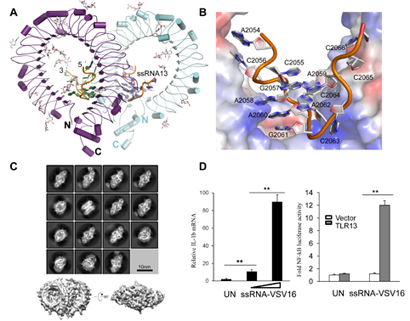Prof. Jijie Chai’s group from Tsinghua published an article in Nature & Molecular Biology, revealing the molecular mechanisms of specific recognition of single-standed RNA by the innate immune receptor, Toll-like receptor 13
The research group led by Prof. Jijie Chai, in collaboration with Prof. Hong-Wei Wang’s group, Dr. Jiawei Wang’s group from School of Life Sciences, Tsinghua University, and Dr. Dekai Zhang’s group from Texas A&M University, published a paper in Nature Structural & Molecular Biology online on August 31, 2015. The paper entitled "Structural basis for specific recognition of single-stranded RNA by toll-like receptor 13” reported the crystal structure of the TLR13-ssRNA complex, revealing the molecular mechanism of ssRNA sequence- and conformation-specific recognition by TLR13. Innate immunity is the first defense line of immune system, allowing multicellular organisms to respond quickly to microorganisms and consequently eliminating them. The membrane-localized Toll-like receptors (TLRs) have crucial roles in innate immune system by functioning as pattern-recognition receptors that detect the presence of the microbe-specific components pathogen-associated molecular patterns (PAMPs) or host-derived danger signals. TLR13 recognizes a conserved sequence from bacterial 23S rRNA to trigger innate immune response. The structural mechanism underlying TLR13 specific recognition of the RNA remains poorly defined.

Fig. The structure of TLR13 in complex with ssRNA
(A) the crystal structure of TLR13-ssRNA
(B) the specific recognition of ssRNA by TLR13
(C) the cryo-EM structure of TLR13-ssRNA
(D) the viral-derived ssRNA induces TLR13 activation
In collaboration with the research groups of Profs. Hong-Wei Wang and Jiawei Wang, Jijie Chai’s group determined the crystal structure of TLR13 in complex with a 13-nt ssRNA from rRNA using the phases from cryo-EM, a new method for determination of crystal structure. The complex structure revealed that the both sequence and stem-loop-like conformation of the ssRNA are important its specific recognition by TLR13. This mechanism allowed them to identify a viral-derived 16-nt ssRNA that was shown to have a similar activity to the 13-nt ssRNA in TLR13 activation. This research revealed a novel mechanism of ssRNA recognition by a protein, suggesting that rRNA needs processing or degrading to function as PAMP.
Wen Song (PhD student), Jia Wang (PhD student) and Dr. Zhifu Han from School of Life Sciences, Tsinghua University, are co-first authors; Prof. Jijie Chai, Prof. Hong-Wei Wang and Dr. Jiawei Wang from School of Life Sciences, Tsinghua University, are the corresponding authors of the paper; Heqiao Zhang (PhD student) and Weiguang Wang (PhD student) and Dr. Shilong Fan from School of Life Sciences, Tsinghua University and Prof. Junbiao Chang from Zhengzhou University also participated in part of the work. This research was funded by State Key Program of National Natural Science of China.
The paper links:http://www.nature.com/nsmb/journal/vaop/ncurrent/full/nsmb.3080.html

